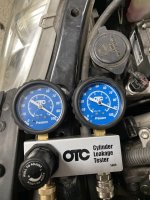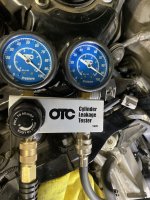My father-in-law's 2008 Camry V6 has a misfire on cyl #3. This is the middle cylinder on the rear bank.
The misfire can ONLY be duplicated under full-throttle acceleration while climbing a steep hill. You can do full-throttle acceleration from a stoplight all day and the issue will never occur.
Under normal driving conditions the vehicle drives perfectly fine. I drove it normally for over 400 miles and it did not develop any misfires.
Fuel trims are normal, +/- 5%.
So far, the following troubleshooting has been done:
- Inspected spark plugs. Plugs are OE, in good condition and gap is correct.
- Installed new Denso Ignition Coils on the Rear Bank (1/3/5). This vehicle still has the "problematic" early style coils. No change.
- Swapped injector #3 with injector #4. No change.
- Relative compression test is normal.
At this point, my plan is to remove the rear valve cover and inspect the valve springs with a boroscope. I have been advised that valve spring failure on the early 2GR-FE engines is a rare but known issue.
Note: this car has recently displayed P0301, P2237 and P2240 faults but at this time, I can only duplicate the P0303 fault.
Any assistance or direction is appreciated. Thanks.
The misfire can ONLY be duplicated under full-throttle acceleration while climbing a steep hill. You can do full-throttle acceleration from a stoplight all day and the issue will never occur.
Under normal driving conditions the vehicle drives perfectly fine. I drove it normally for over 400 miles and it did not develop any misfires.
Fuel trims are normal, +/- 5%.
So far, the following troubleshooting has been done:
- Inspected spark plugs. Plugs are OE, in good condition and gap is correct.
- Installed new Denso Ignition Coils on the Rear Bank (1/3/5). This vehicle still has the "problematic" early style coils. No change.
- Swapped injector #3 with injector #4. No change.
- Relative compression test is normal.
At this point, my plan is to remove the rear valve cover and inspect the valve springs with a boroscope. I have been advised that valve spring failure on the early 2GR-FE engines is a rare but known issue.
Note: this car has recently displayed P0301, P2237 and P2240 faults but at this time, I can only duplicate the P0303 fault.
Any assistance or direction is appreciated. Thanks.








